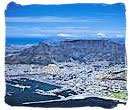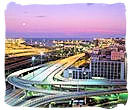-
You are here:
Home
›
-
South Africa's weather
›
-
South Africa's climate
Enjoy South Africa 's climate,
delightfully mild and pleasant all year round
South Africa 's climate with its subtropical
and temperate weather is situated in the southern hemisphere, which means that the seasons are
the opposite of those in Europe, the United States and everywhere else in the northern
hemisphere.
Our country is surrounded by oceans on three sides, west, south and east.
This feature together with the higher altitude of the large interior plateau accounts for its
more temperate climate conditions, compared to other areas within the subtropical belt.
South Africa's large number of between 8 and 9 sunshine hours per day, is
considered to be among the highest of daily averages world-wide, when put side by side with for
example 6.9 in new York, 6.4 in Rome and 3.8 in London.
South Africa's position on the earth globe between 22 and 34 degrees
southern latitude, puts it within the subtropical belt of high pressure systems in winter and
low pressure systems in summer, that circles the globe between 25 and 30 degrees southern
latitude. This produces a relatively dry climate in South Africa, with an abundance of
sunshine.
click on the picture below...and then click on it again, to view an
enlargement.
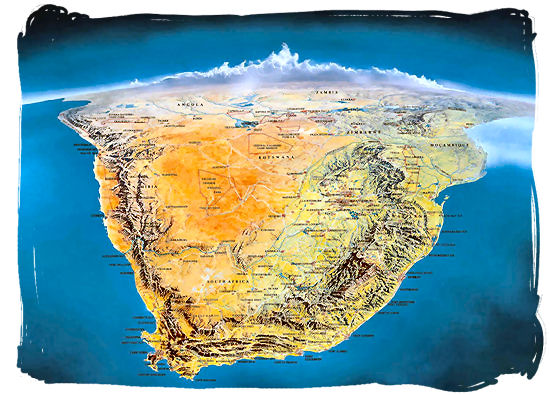 Interactive map showing view from space of the southern tip of Africa
Interactive map showing view from space of the southern tip of Africa
Climate Features,...
Apart from a small region in the north-east with a desert like climatic
environment, South Africa 's climate conditions as a whole range from mild and pleasant on the
large interior plateau, subtropical in the north-eastern region, to Mediterranean in the
south-western region of the country.
The warm north to south-flowing Mozambique-Agulhas current in the Indian
ocean at the east coast and the cold south to north-flowing Benguela current in the Atlantic
ocean at the west coast of our country, have an important effect on South Africa 's weather.
The contrast in temperatures between these two currents, largely accounts for the striking
differences in climate and vegetation between the east and west coasts.
Map showing South Africa's main climate features
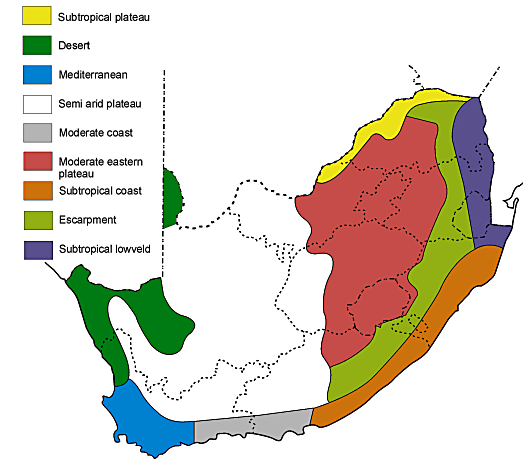
Another feature that influences South Africa 's climate conditions, is the
variation in altitude in the physical geography of the country. Geographically South Africa can
be divided into three main regions, the huge interior plateau, the vast mountain ranges
encircling the plateau in the south, west and east, called the escarpment and the area lying
between these mountains and the sea, called the coastal belt.
Top of Page
The Rainfall,...
Total overall average annual rainfall for South Africa is 464 mm, compared
with an overall world average of 860 mm. In most of the country the rainfall occurs during
summer. It is unpredictable and unreliable and is largely influenced by moist air moving in
from the Indian ocean in the east and south east. Total rainfall is greatest in the east of the
country and gradually decreases westward.
Map showing South Africa's average rainfall figures
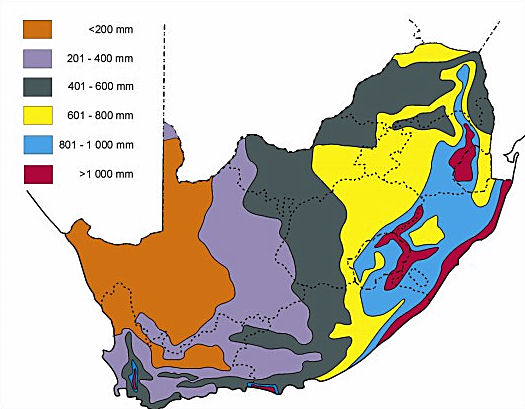
The wettest regions are the eastern provinces Mpumalanga, Orange Free State,
Gauteng and Kwazulu Natal with an average annual rainfall of up to 900 mm. The average annual
rainfall in the central area of the country is around 400 mm, decreasing west ward to less than
200 mm, leaving the western and north western regions of the country with semi-desert and
desert type climates.
An exception to the overall rainfall pattern of South Africa 's climate is
the south-western part of the Western Cape province. Here we find a typical Mediterranean
climate with the rainfall occurring during the winter period, coming in from the Atlantic
ocean. The average annual rainfall for this area is 515 mm.
Table of average annual rainfall figures.
| CAPE TOWN |
515 mm |
| JOHANNESBURG |
802 mm |
| DURBAN |
1009 mm |
| PRETORIA |
674 mm |
| BLOEMFONTEIN |
559 mm |
| PORT ELIZABETH |
1120 mm |
| KIMBERLEY |
414 mm |
| PHALABORWA |
747 mm |
| POLIKWANE |
468 mm |
| UPPINGTON |
189 mm |
Top of Page
The Temperatures,...
Despite a latitude span of 13 degrees from south to north, average annual
temperatures across the interior plateau are surprisingly uniform. There is hardly any increase
in temperature from south to north, contrary to what one would have expected.
This is due to the increasing height of the interior plateau towards the
northeast. The difference in average annual temperature between cape town at 17 degrees Celsius
and Pretoria at 17,5 degrees Celsius over a distance of close to 1500 km for instance, is only
half a degree Celsius.
Map showing South Africa's mean average summer temperatures
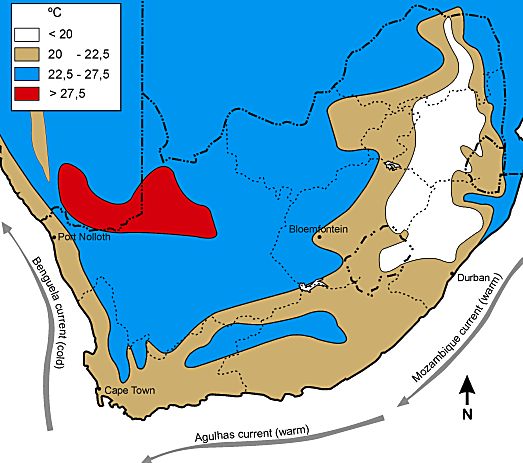
Going from east to west, the story is quite different. The influence of the
Mozambique-Agulhas current at the east coast and the Benguela current at the west coast on the
South Africa climate, is considerable. The difference in average annual temperature between
Durban on the east coast and Port Nolloth on the west coast for instance, is as much as 6
degrees Celsius.
The effects of these two currents can even be seen at the narrow Cape
peninsula, where water temperatures average up to 4 degrees Celsius higher on the
eastern False Bay side, then on the western Cape town harbour side.
Map showing South Africa's mean average winter temperatures
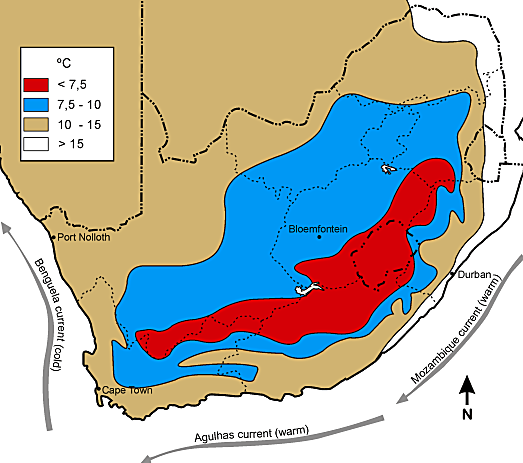
South Africa 's climate knows temperature variations ranging from cold,
mild winters with day temperatures averaging 10 – 20 degrees Celsius, to warm, hot summers
with day temperatures averaging 25 – 35 degrees Celsius.
Temperatures above 30 degrees Celsius are fairly common in South Africa in
summer. In regions like the lower Orange valley, the Karoo, the Mpumalanga lowveld and the
north coast of kwazulu-Natal, they can exceed 38 degrees Celsius.
Table of average day temperatures in degrees celsius.
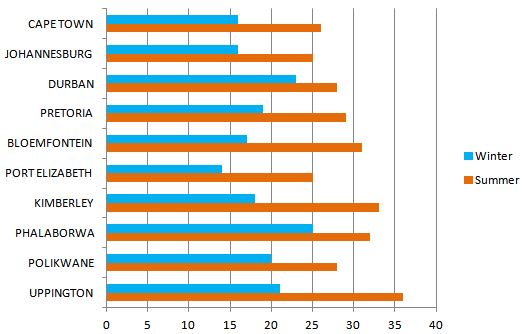
Top of Page
-
You are here:
Home
›
-
South Africa's weather
›
-
South Africa's climate












